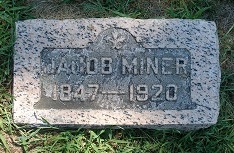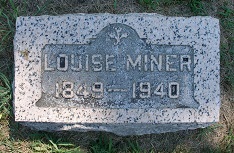
|
Jacob
Miner |
Jacob
Miner
was born under the name "Minerd" on May 18, 1847 in Washington Township, Wood County,
OH, the son of Samuel and Susanna (Hueston)
Minerd.
Union Hill Cemetery
He built many bridges in his native Wood County, and was a neighbor of the parents and brother of General George
Armstrong
Custer. He dropped the "d" from the family name at some point in
time.
On July 2, 1871, when he was 24 years of age, Jacob entered into marriage with 21-year-old Louisa "Louise" Finkenbiner (Dec. 25, 1849-1940), a Christmas Day baby and the daughter of David and Susan (Snyder) Finkenbinder who had settled in the county in 1848. Officiating was justice of the peace John Campbell. Their marriage endured the ups and downs of a remarkable 51 years until the separation of death.
They together produced a brood of seven children – Edith Keeler, Charles Miner, Jay C. Miner, Jennie Goodger, Susan Bemis, Hugh Valentine Miner and Edna Asmus. Sadly, son Charles died as an infant in November 1873 -- to see his bio, complete with a photograph of him in death, click here.
Jacob was a jack of all trades -- a bridge builder and stonework contractor as well as a farmer and a butcher. The Index to Commissioners Journal of Wood County lists many contracts which he and his brother in law, William J. Burditt, received over the years.
 |
| Jacob and Lousa's marriage license, spelled with the "d." Courtesy Beverly (Hansen) Miner |
The two men built simple-span structures over
local creeks as well as large man-made ditches that drained surface water from
the flat farm fields. These included bridges in the towns or townships of
Tontogany, Freedom, Pemberville, Milton, Weston, Bloom, Jackson and Washington.
The Index covers the years 1895 to 1901.
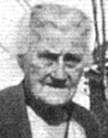
Louise Miner
In
fact, in the year 1892, Jacob was the second highest-paid bridge contractor in
Wood County as paid from the County Bridge Fund, and reported in the Wood
County Sentinel. He is known to have been paid $10 by the county in November 1915 for repairing bridges. His name constantly was printed in the local newspapers for his bridge and stone contracts and their social activities with families of their grown children.
He also generated income as a stone mason. The Sentinel-Tribune reported in July 1892 that he had received $200 for "stone work north of Haskins" and $651.36 in August 1892 for "stone work, bridge and grading in Middleton twp." He also is known to have provided services for installing stone for ditch and bridge abutments and for laying sewers.
Jacob was a member of the local school board. In 1886-1887, he and others voted for the “innovation” of acquiring “modern school furniture,” according to Beers’ 1897 Commemorative Historical and Biographical Record of Wood County.
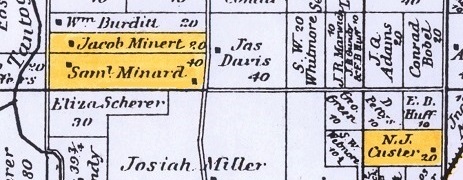 |
| Above: 1886 map of Minerd/Custer farms, Tontogany. Below: East Main Street in Tontogany -- note the "Lumber and Coal Office" sign |
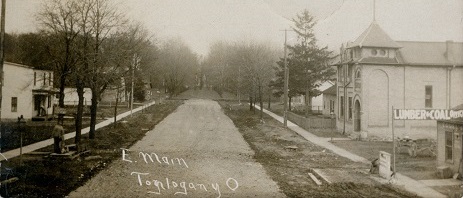 |
He
and Louise resided next to his parents north of the village of Tontogany in Wood
County. In 1871, for the sum of $1,200, Jacob and William J. Burditt jointly
purchased a 20-acre farm belonging to Jacob’s father.
This farm appears in the 1871 landowner map of Wood County, and was next to the
farm of Emanuel H. Custer and his son Nevin J. Custer. (Emanuel was the father,
and Nevin the brother, of General Custer.) In fact, Jacob's sister Rebecca
is thought to have been a sweetheart of another Custer brother, Civil War hero
Thomas, who also was killed at the Battle of Little Big
Horn. Jacob's farm also is depicted Griffing Gordon’s 1886 Atlas of
Wood County, Ohio,
|
Union Hill Cemetery
|
Went over to house and found Mrs. Eddmon and Nellie Hartsing in house. Dr. Eddmon said he was locked up and going to house when shot was fired, afterwards he said he [Eddmon] was reading a newspaper, and later said he was counting his cash. Witness described position of body and said Dr. Eddmon suggested moving it to calaboose. Saw no rubbish. Yard was clean. There was no fire when I got there. Ground was hard, it was a cold night."
Tongues wagged around town on rumors that the victim and the doctor had been having a love affair and that he had killed her, or that his jealous wife pulled the trigger or that her jealous husband had shot her in a spurt of rage. A jury found the doctor not guilty and dropped charges against his wife. The building where the killing took place became the Wires Auto Service Station and was torn down in mid-November 1975.
Jacob spent significant amounts of time time with his mentally ill, Civil War veteran brother Alpheus and probably kept him out of much trouble. Later, when there was a court case involving Alpheus, and enemies of the family tried to prove him insane, Jacob explained why his testimony was radically different than that of friends and neighbors: “I was with him a great deal, and I may have not noticed what others notice in him. I may have been so accustomed to him as not to notice what others swear to.”
There may have been friction between Jacob and his brother in law, William L. Jewell, after Jewell was named the legal guardian of Alpheus. In fact, Jacob once said that Jewell’s “reputation is bad. He is regarded as a trickster and so spoken of.”
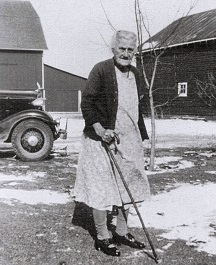
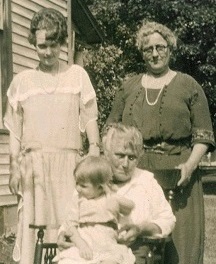
Louise Miner and seated in a 4-generation photo with daughter Jennie Goodger and granddaughter Nellie Parcell
In
the 1890s, Jacob’s widowed father came to live in their household, and may
have remained there until his death in 1904.
During the summer of 1907, one of the Miners' sons contracted smallpox. Although he was the only one ill, the family was quarantined in their residence together for 41 days. Once released from confinement, Jacob went into town "on his way to Galatea," said the Sentinel-Tribune, "to look after some of his work which has been held up six weeks..."
He escaped serious injury in May 1915 when his automobile veered into a ditch north of Bowling Green, receiving bad lacerations of the left hand. Then after recovering from a severe illness in October 1915, the local newspaper said he "is 68 years old but does not look it and evidently can lookk forward to a long life, as his father died at 96, his grandfather at 106 and his great-grandfather at 116 years."
Stricken with influenza and bronchitis, Jacob
died at the age of 72 on March 4, 1920, in the township of his birth.
He was buried in the family plot at Union Hill Cemetery. Unfortunately,
the local newspaper, the Daily Sentinel Tribune, did not carry an
obituary.
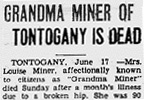
Obituary, 1940
Louise outlived her husband by two decades, and resided with her son Hugh as well as "with her daughters in Haskins and vicinity." In late January 1932, while with the Bemises, she fell and broke her hip with a compound fracture. Nurse Otelia Asmus provided nursing care for her at that time. By 1940, her summer months were spent in the Bemis residence and the winter ones in the Asmus home.
She passed away at age 90 in Bowling Green on June 16, 1940, from the effects of a broken hip. Her death occurred just two days after the birth of a great-grandson in the same hospital. The local newspaper said she had been "affectionately known to citizens as 'Grandma Miner' " and published this editorial:
What a fine personality a woman must have who is known to the people of a community as "Grandma." The title implies a kindly, definite interest in others, sympathy with them when in distress, rejoicing with them in their hours of gladness, a glossing over of their foibles and shortcomings. It was not her ninety years that had given Mrs. Louise Miner, of Tontogany, the title of "Grandma." It had been won by her life. And in every community, in many a section of cities, there is some woman who, although she is not called Grandma, is looked upon by many as though she truly were such. Such women are jewels whether they be diamonds in the rough or polished. They do much to make this old world a better place in which to live. They are the sun and moon that illuminate many an otherwise dark path.
Copyright © 2001-2003, 2006, 2010, 2022-2023 Mark A. Miner
